Although Israel isn’t exactly known as a world-renowned wine region (yet), wine has been cultivated in the area since pre-biblical times. And yes, it hasn’t been highly regarded in the past, but that is largely because the export market is very different than the fine boutique wines available here. This is all changing, slowly, and Israeli wine is finally earning some respect. Not that I’m a huge fan, but the famed American wine critic Robert Parker, for example, devoted an unprecedented nine pages in his most recent buyer’s guide (more pages than South Africa and on par with New Zealand) with 12 wines scoring 90 points or higher.
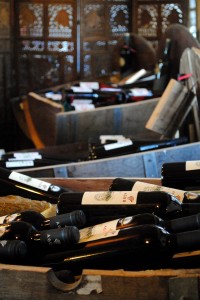 While there are 380 vineyards in this small country I now call home, most of them are boutique wineries (meaning they produce less than 500,000 bottles per year) and many are small operations in someone’s house. Besides being difficult to find and there being a language barrier, if the winemaker isn’t home, there’s no tour. This combined with the fact that drinking and driving really aren’t my thing meant that I needed a tour guide.
While there are 380 vineyards in this small country I now call home, most of them are boutique wineries (meaning they produce less than 500,000 bottles per year) and many are small operations in someone’s house. Besides being difficult to find and there being a language barrier, if the winemaker isn’t home, there’s no tour. This combined with the fact that drinking and driving really aren’t my thing meant that I needed a tour guide.
I first met Esther Cohen at Wine and Dine Be’er Sheva‘s event at Aquaria, where she led a wine tasting and I learned that she runs My Israel Wine Tours. As the only company in the country dedicated exclusively to organizing wine tours, Esther is your go-to gal if you have any interest in exploring the country’s vino. And so we organized a tour of the Judean Hils for 18 MSIH students last Friday.
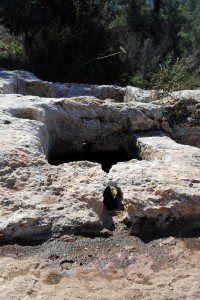 We got an early start so as to be back before shabbat and were sipping wine by 10am; what better way to spend a Friday morning? And the day could not have been more beautiful. Sunny and warm, no one would have been able to stay cooped up inside for long (did I mention that this was mid-January?). On the ride over Esther clued us in to some of the fascinating history of the wine industry in Israel.
We got an early start so as to be back before shabbat and were sipping wine by 10am; what better way to spend a Friday morning? And the day could not have been more beautiful. Sunny and warm, no one would have been able to stay cooped up inside for long (did I mention that this was mid-January?). On the ride over Esther clued us in to some of the fascinating history of the wine industry in Israel.
The story begins, she says, thousands of years ago when Moses sent two spies into Israel to see if it was inhabitable. When they returned with vines, he knew the land could sustain human life. Down the line King David supposedly was quite the oenophile and had an entire court dedicated to wine production and sales. To bring this to life, the first stop on the tour was an ancient, 2100-year old wine press. The way they managed to use the land and limited technology to press and ferment the grapes is nothing short of astonishing.
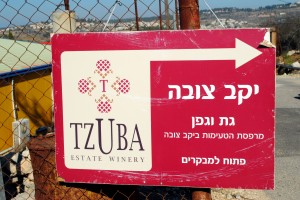 The first of two wineries on our tour was Tzuba, which is located on a kibbutz that started in the 1950s and has about 500 members today. Paul, the winemaker, moved to the kibbutz from South Africa in the late 90s and has been heading up production ever since. They sell 80% of their grapes (37 hectares of vines) to other wineries and use the remaining to produce 13 varieties and about 40,000 bottles annually. Tzuba also uses only natural pesticides and sprays just six times a year (many wineries spray far more often).
The first of two wineries on our tour was Tzuba, which is located on a kibbutz that started in the 1950s and has about 500 members today. Paul, the winemaker, moved to the kibbutz from South Africa in the late 90s and has been heading up production ever since. They sell 80% of their grapes (37 hectares of vines) to other wineries and use the remaining to produce 13 varieties and about 40,000 bottles annually. Tzuba also uses only natural pesticides and sprays just six times a year (many wineries spray far more often).
The soil around Tzuba has lots of limestone, the climate is dry, and the vineyard is at an altitude of 700 meters, and this terroir really shows in each of their wines. First we tasted their Chardonnay, one of only two white wines they produce. Aged 50% in barrels and 50% in stainless steel, this is a nice, clean white, not buttery at all. With notes of grapefruit and guava and hints of flint and limestone, it proved to be a pleasant, easy drinking wine perfect for our lovely, warm day. Next up was the 2007 Merlot, which is made from 100% Merlot grapes and aged for 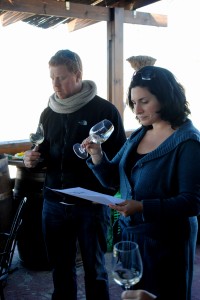 14 months in French oak, making it an elegant and versatile wine. While dark berries make up the prominent flavor, notes of cinnamon, vanilla, and honey soften the wine and round it out. Paul suggested that it would go just as well with fish as with meat.
14 months in French oak, making it an elegant and versatile wine. While dark berries make up the prominent flavor, notes of cinnamon, vanilla, and honey soften the wine and round it out. Paul suggested that it would go just as well with fish as with meat.
The 2008 Cabernet Sauvignon that we tried next is a classic dry Cab with lots of tannins and was a little too bold for some people’s palates. As Paul noted, this wine should not be paired with delicate food as its flavors completely dominate your mouth. I enjoyed this big wine, which would complement meat or any intensely flavored or spicy dish. I have a feeling that it’s the kind of wine that is good on its own, but really shines with that kind of food. Prunes, coffee, slightly ripe cherries, and just the slightest tickle of mint were the primary flavors.
Finally, we tried the crown jewel of Tzuba’s offerings, the 2006 Mitsuda Reserve. This is Paul’s special blend; each year he makes a few blends then calls together a tasting panel of wine experts and allows them to vote on their favorite. That is what he produces as that year’s blend. This one is 75% Cabernet Sauvignon, 20% Cabernet Franc, and 5% Malbec. As it is slightly aged (2006 is almost as aged as an Israeli wine gets), this light- to medium-bodied red is complex and elegant with nicely integrated flavors and soft tannins. This is a wine for an occasion, and the bottle that we went home with.
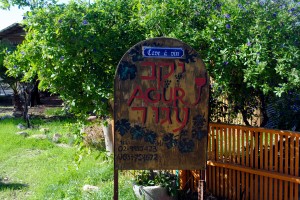 Next up on our little adventure was Agur Winery, which is another boutique winery that produces 30,000 bottles per year. Located next to the winemakers house, Shuki, the eccentric winemaker, was napping when we arrived. Lucky for us Esther woke him so we could hear him philosophize about love, life, and wine. Shuki is the son of a diplomat and speaks seven languages; he is also a character and completely passionate about wine. He explained his ideas about sensual intelligence, which he says is developed as a child, and his feeling that “wine tasting – and tasting in general – is all about the sensual experience.”
Next up on our little adventure was Agur Winery, which is another boutique winery that produces 30,000 bottles per year. Located next to the winemakers house, Shuki, the eccentric winemaker, was napping when we arrived. Lucky for us Esther woke him so we could hear him philosophize about love, life, and wine. Shuki is the son of a diplomat and speaks seven languages; he is also a character and completely passionate about wine. He explained his ideas about sensual intelligence, which he says is developed as a child, and his feeling that “wine tasting – and tasting in general – is all about the sensual experience.”
We first tried the 2009 Blanca, a blend of 45% Viognier and 55% Johannesburg Reisling. The wine is nicely balanced, but slightly sweet from the Reisling. Something I would enjoy when served to me, but not what I would seek out. Next up was the Rosé, a serious, dry rosé made from 60% Cabernet Franc and 40% Cabernet Sauvignon grapes. As with all 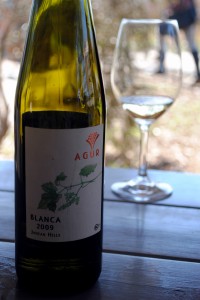 rosés, which are not made for aging, this one should be consumed fresh, in the year it is made. Shuki explained part of the process, and how he thickens the wine without sweetening it as such: “As an aesthetic craftsman, I do not like to have the oak overpower the grape. However, I use the trick of using oak in rosé by stirring the dead lees into the wine to thicken it with glycerin without sweetening.”
rosés, which are not made for aging, this one should be consumed fresh, in the year it is made. Shuki explained part of the process, and how he thickens the wine without sweetening it as such: “As an aesthetic craftsman, I do not like to have the oak overpower the grape. However, I use the trick of using oak in rosé by stirring the dead lees into the wine to thicken it with glycerin without sweetening.”
The 2009 Kessem is named for a sort of a shortened combination of Cabernet Sauvignon and Merlot, which are the main grapes in the wine. Aged for 12 months in oak, the 2009 that we sampled was bottled just a few weeks ago. It was spectacular, but as Shuki explained, it still needs to mature slightly. “Here what I was trying to express,” he explains, “was the red fruit. Think of a red, juicy fruit that you bite into and it is a little under-ripe. In a year or year and a half it will develop into a ripe wine.” If any of us had decent wine storage capabilities, I’m sure many of us would have gone home with this wine. Alas, we’ll just have to go back and visit in a year when it’s ready. Instead, we grabbed a bottle of the 2006 Kessem, which is perfect to drink now. Finally, we had the Reserve, a full-bodied red with lots of black fruit. I couldn’t decide if this or the Kessem were my favorite, but Evan preferred the Kessem.
Before heading back to Be’er Sheva we roamed through the hibernating vineyards and basked in the sun, glass of wine in hand. It was so much fun, Esther and I are already planning our next tour, this time further up north to the Carmel region.
To close, I’m going to leave you with some quotes from Shuki:
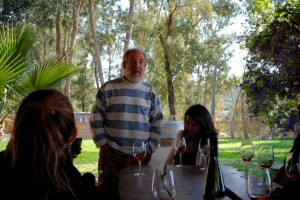 (Or, listen for yourself Here)
(Or, listen for yourself Here)
“Like all aesthetic crafts [winemaking] needs the collaboration of the user.”
“[The wines] are all my children and it’s not fair to ask me my favorite. They are all very different from each other and express their differences.”
“Wine to me is fruit.”
“We are sensually deprived as human beings. Our verbal expression is limited to metaphors. That is why I try to be fair with my metaphors. We are so insecure in our senses and sensual judgement.”
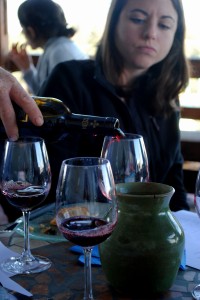 “People ask, ‘What should I taste?’ [when they try a wine]. What a stupid question. What an insecure question. All these big companies do is manipulate our insecurities.”
“People ask, ‘What should I taste?’ [when they try a wine]. What a stupid question. What an insecure question. All these big companies do is manipulate our insecurities.”
“What is truth? There is no truth in the wine. It’s just fermented grape juice.”
“When wine comes in, the secret goes out.” – Hebrew Saying
“Unless you let your heart out, there is no point to gatherings.”
And, his final, parting words to us: “Never fake orgasms.”

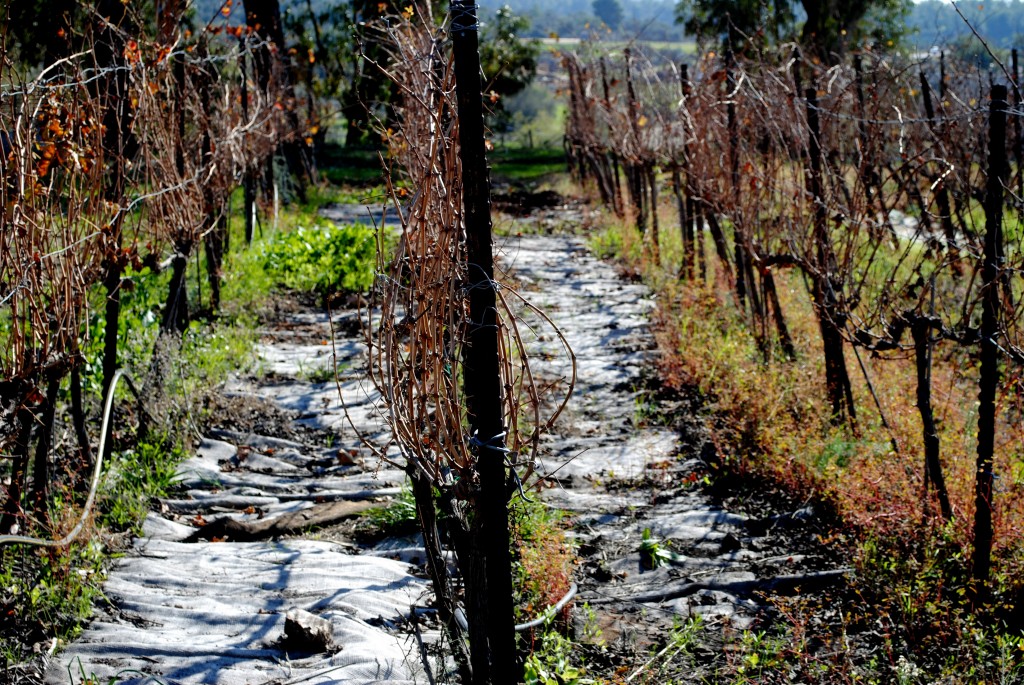
[url=http://www.msnbrand.com/goods-copy-4778.html]カルティエカルティエcléケースを慎é‡ã«è¦‹ã¦ã€ã‚ãªãŸã¯å„ªé›…ã•ã¨æ´—ç·´ã•ã‚ŒãŸã‚«ãƒ«ãƒ†ã‚£ã‚¨ã®èª˜ç™ºã‚’確èªã—ãŸã‹ã£ãŸã‚’賞賛ã™ã‚‹ã“ã¨ãŒã§ãã¾ã™ã€‚カルティエã§å¯†æŽ¥ã«è¦‹ãŸã¨ãã€ä¸€é€£ã®éžå¸¸ã«é¢ç™½ã„ç·šã‚’å–り入れãŸãƒ‡ã‚¶ã‚¤ãƒ³ã‚’生ã˜ã‚‹ã“ã¨ã§ç¢ºã‹ã«æˆåŠŸã—ã€é ãã‹ã‚‰è¦‹ãŸã¨ãã«é…力的ãªå½¢çŠ¶ã‚’ã—ãŸã€‚[/url]